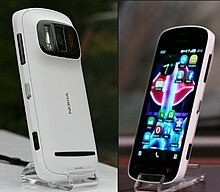
Back نوكيا 808 بيورفيو Arabic نوکیا ۸۰۸ بیورفیو AZB Nokia 808 PureView German Nokia 808 PureView Spanish Nokia 808 PureView Finnish Nokia 808 PureView Italian Nokia 808 Pureview JV 노키아 808 퓨어뷰 Korean नोकिया ८०८ प्युअरव्ह्यु Marathi Nokia 808 PureView Dutch
 | |
| Manufacturer | Nokia |
|---|---|
| Type | Smartphone |
| Series | Nokia 3-digit series |
| Predecessor | Nokia N86 8MP Nokia N87 Nokia N8 |
| Successor | Nokia Lumia 1020 |
| Compatible networks | GSM (850/900/1800/1900 MHz) HSDPA (850/900/1700/1900/2100 MHz) |
| Colors | Black, White, Red |
| Dimensions | 123.9 mm (4.88 in) H 60.2 mm (2.37 in) W 13.9 mm (0.55 in) D 17.95 mm (0.707 in) Bulge |
| Weight | 169 g (6.0 oz) |
| Operating system | Nokia Belle Feature Pack 1, upgradeable to Nokia Belle Feature Pack 2 |
| CPU | ARM11 1.3 GHz processor |
| GPU | Broadcom BCM2763 with OpenVG 1.1 and OpenGL ES 2.0 support |
| Memory | 512 MB RAM |
| Storage | 16 GB |
| Removable storage | microSD up to 1 TB supported[1] |
| Battery | 1400 mAh Li-ion, removable (Nokia BV-4D) |
| Rear camera | 41 MP 1/1.2 in sensor Carl Zeiss optics F-number: f/2.4 ND filter Xenon flash LED light 1080p 30 fps video with continuous autofocus |
| Front camera | 0.3 MP; 480p 30 fps |
| Display | 4 in (10 cm) AMOLED 2.5D curved nHD display (640x360 pixels) Gorilla Glass with easy-clean coating |
| Connectivity | Sensors: Other:
|
| Development status | Discontinued |

The Nokia 808 PureView is a Symbian-powered smartphone by Nokia. It was first unveiled on 27 February 2012 at the Mobile World Congress (MWC) and released in May 2012.[2] It is the first smartphone to feature Nokia PureView Pro technology, a pixel oversampling technique that reduces an image taken at full resolution into a lower resolution picture, thus achieving higher definition and light sensitivity, and enables lossless digital zoom.[3] It was one of the most advanced camera phones at the time of its release.[4][5]
The Nokia 808 PureView features a 41 MP 1/1.2 in (10.67 × 8 mm) sensor and a high-resolution f/2.4 Zeiss all-aspherical 1-group lens. The 808's sensor was the largest (over 4 times larger than typical compact cameras) sensor ever to be used in a cameraphone at the time of its launch, a record previously held by Nokia's N8[6] and, as of September 2014, by the Panasonic Lumix CM1.[7]
As of 2024, despite larger 1" sensors and AI processing modern cameraphones can’t provide resolution better than Nokia 808 PureView at least in broad daylight.[8][unreliable source?]
On 24 January 2013, Nokia officially confirmed the 808 PureView to be the last Symbian smartphone.[9] In July 2013, Nokia released the Lumia 1020, a successor running the Windows Phone operating system common to Nokia's newer products.[10][11][12]
- ^ Loginov, Nick (2022-01-16). "1TB on Nokia PureView 808". UnlistedHoldout. Retrieved 2023-04-19.
- ^ "Nokia announces PureView 808 with a 41 MP sensor". GSMArena.com. 27 February 2012. Retrieved 2024-05-23.
- ^ "41MP Nokia 808 smartphone hints at pixel-binning future for small sensor cameras". Digital Photography Review. 27 February 2012. Retrieved 2024-05-23.
- ^ Vasile, Cosmin (1 March 2012). "MWC 2012: Nokia 808 PureView Wins "Best New Mobile Handset, Device or Tablet" Award". Softpedia News. Softpedia. Retrieved 2024-05-23.
Nokia 808 PureView has just become the most advanced camera phone that will soon be available on the market.
- ^ "Just Posted: Nokia 808 PureView Review". Digital Photography Review. 30 July 2012. Retrieved 2024-05-23.
On paper, the 808 offers the most advanced camera features of any smartphone...
- ^ Turner, Debbie (28 February 2012). "Nokia 808 PureView 41MP phone could kill compact camera". phonesreview.co.uk. Retrieved 2024-05-23.
- ^ Rehm, Lars (15 September 2014). "Panasonic announces Lumix DMC-CM1 smartphone with 1-inch sensor". Digital Photography Review. Retrieved 2024-05-23.
- ^ Loginov, Nick (7 August 2024). "Nokia PureView 808 vs Oppo Find X6 Pro". UnlistedHoldout. Retrieved 2024-08-07.
- ^ Lunden, Ingrid (24 January 2013). "Nokia Confirms The PureView Was Officially The Last Symbian Phone". TechCrunch. Yahoo! Inc. Retrieved 2024-05-23.
- ^ "Nokia Lumia 1020 hands-on". GSMArena.com. 11 July 2013. Retrieved 2024-05-23.
- ^ Litchfield, Steve (11 July 2013). "The Nokia 808's successor is unveiled.... on Windows Phone 8". All About Symbian. Retrieved 2016-05-12.
- ^ "Nokia Lumia 1020 overview: Has the best gotten better?". DxOMark. 11 October 2013. Retrieved 2024-05-23.